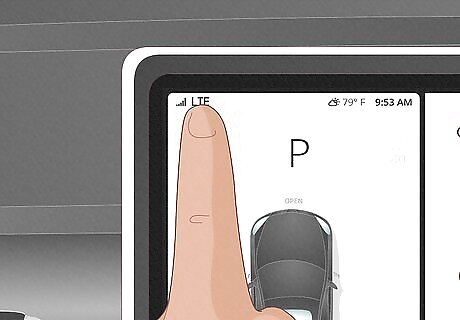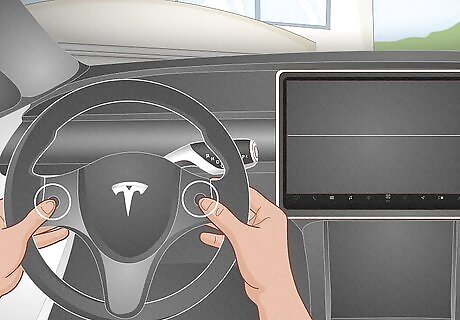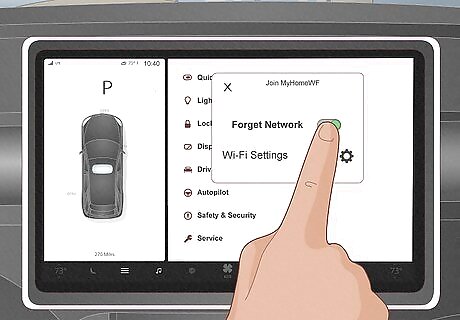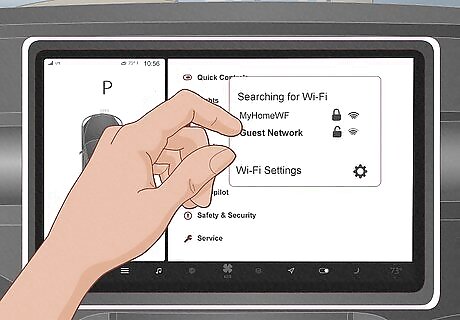
views
- Press the “LTE” or Wi-Fi icon on the top of your touchscreen to open the Wi-Fi menu.
- Click on the network you want to connect to and put in the password.
- If you can’t connect, reboot your touchscreen, move your car closer to the router, or switch to a guest network.
Connecting to a Wi-Fi Network

Open the “Controls” screen and press the connectivity icon. At the top of the screen, there’s an LTE symbol next to 5 bars, just like on your phone. Click that symbol and a list of available Wi-Fi networks will pop up. Put your car in park the first time you connect to any given network. You can also use a mobile hotspot to stay connected on the go. Just turn on your hotspot before you start searching for networks.

Select your Wi-Fi network and put in the password. Connect to the Wi-Fi like you would on any other device. Once your Tesla is on the network, it’ll connect whenever it’s in range. If you want to connect to a hidden network, press “Wi-Fi Settings” at the bottom of the list, then type in the name of the network. Wi-Fi networks need to have WPA, WPA2, or no security for the Tesla to be able to connect. Models X and S built before 2018 can only connect to routers that support 2.4GHz frequencies.

Wait for a green check mark to appear by the network name. Once your Wi-Fi or hotspot has finished connecting, a green circle with a check mark will appear beside it. When you leave the network menu, the LTE icon will switch to a Wi-Fi icon (3 curved lines). Connecting can take up to 30 seconds, so don’t worry if it doesn’t instantly pair.

Consider getting Tesla Premium Connectivity. Teslas have an optional connectivity package for $9.99 a month. It gives you a few extra features, like “Sentry Mode” (where you can remotely view cameras in your car) and live traffic updates, as well as 24/7 Wi-Fi. It basically turns your car into a smartphone. Subscribe to Tesla Premium Connectivity by selecting your car in the Tesla app, then click “Upgrades” and “Software Upgrades.” Click “Subscribe” at the top of your screen, then “Add” next to Premium Connectivity. You’ll be taken to a checkout screen where you can put in your payment information. Model Ys, Model 3 Standard Ranges, Standard Range Pluses, or Rear-Wheel Drives from before June 30th, 2018 aren’t eligible for Premium Connectivity. While you can’t get the premium features, using a mobile hotspot will also allow you to have internet on the go.
Troubleshooting

Poor connection If you’re getting a weak signal in your car, it may be because the router is too far away. The easiest way to fix this is by either physically moving the router or parking your car closer. The Wi-Fi antenna is in the right side mirror, so get that part of your car as close as you can. You can also get a Wi-Fi extender to boost your router’s signal. If your connectivity doesn’t improve, you may need to replace your router. Get one that accepts 2.4GHz frequencies if you have a pre-2018 model X or S.

Lost connection If you can’t find a network you’ve already connected to, use the tried and true tech fixing trick: turning it off and then back on again. Reboot your touchscreen by pressing down the two scroll buttons on your steering wheel until the screen turns black. After a few seconds, it’ll come back on. It can sometimes take up to 4 minutes for Wi-Fi to reconnect after a reboot. Wi-Fi can also go out if your car is in reverse or drive. Go to Wi-Fi settings and press “remain connected in drive” to keep connectivity.

Not connecting If your Wi-Fi won’t connect at all, there could be a problem with your antenna or router. If it still doesn’t work after you’ve rebooted your touchscreen and turned your router off and on again, it may be time to schedule a service visit or pick up a new router.

Not updating Teslas update through their Wi-Fi, so if your software doesn’t receive anything (but your Wi-Fi still says it’s connected), something’s wrong. Click on the Wi-Fi symbol then your network, and click “Forget.” Reconnect the network as you would normally. You may also need to change your UDP timeout. Different routers have different processes, so do some research on your device. Change the number to “60 seconds.”

Connection turns on and off Some home internet systems have DLNA (Digital Living Network Alliance) Digital Media Server on their main networks, which can cause spotty connections in Teslas. To fix this, switch to a guest network (which doesn’t have DLNA servers).




















Comments
0 comment